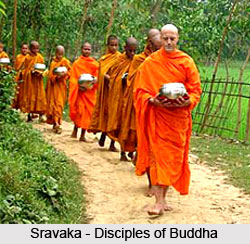 Sravaka in Sanskrit means `a hearer` or `disciple`. Sravaka is the name given to the Buddhist followers or disciples.
Sravaka in Sanskrit means `a hearer` or `disciple`. Sravaka is the name given to the Buddhist followers or disciples.
In Nikaya Buddhism, it is mentioned that Sravaka is a Buddhist disciple who accepts follows Buddhist teachings.
Sravaka in the Mahayana texts are compared with Bodhisattva. Sravaka are of four types are monks (bhikkhu), nuns (bhikkuni), laymen (upasaka) and laywomen (upasika). There are further three types of disciples or Sravaka based on religious accomplishment, they are Chief Disciple (agrasravaka), Great Disciple (maha-sravaka) and Ordinary Disciple (prakrtisravaka).
The Chief Disciples of Sravaka are Sariputta and Mahamoggallana. Then is the Great Disciples of Sravaka who are Mahakassapa, Ananda, Anuruddha and Mahakaccana. The Ordinary Disciples are found in majority who are dedicated to the Buddha and his teaching.
Sravaka also consist of Noble disciples known as Ariya-savaka. The disciples are any lay disciples (upasaka) of the Buddha. The Noble disciples are those who are on the path to enlightenment. The ordinary disciples are contrasted with the noble disciples.
It is listed that there are `four pairs` and `eight types` of noble disciples or sravaka. This refers to devotees, who have achieved one of the four stages of enlightenment, stream-enterer (sotapatti), once-returner (sakadagamita), non-returner (anagamita) and arahant.
In each of these stages, there is a `pair` of possible disciples, one who is on the stage`s path (magga); the other who has achieved its fruit (phala). Each stage represents a `pair` of individuals, the path traveler (maggattha) and the fruit achiever (phalattha).
The Buddha often contrasts the `instructed noble disciple` with the `uninstructed worlding`. In the `Etadaggavagga`, the Buddha categorizes eighty types of disciples, forty-seven categories for monks, thirteen for nuns, ten for laymen and ten for laywomen.
There are two `Community of Sravaka` in Buddhism. The first is the `community of monks` (bhikkhu-sangha or sammati-sangha), that refers to a community of four or more monks. The next `community of disciples` refers to the community of monks, nuns, and male and female lay-followers, especially those who are on the path to enlightenment.









